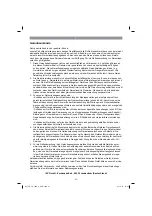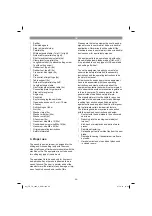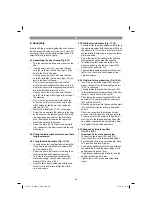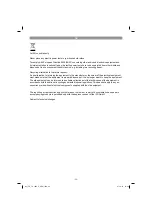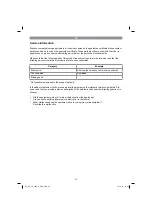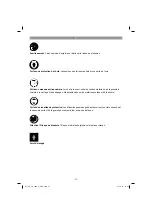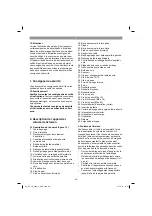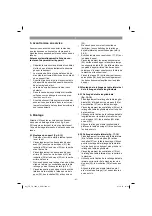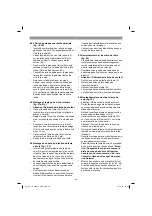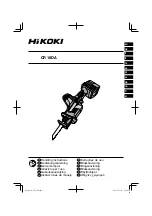
GB
- 30 -
on the purpose.
•
The parallel stop is set at right-angles to the
guide rail at the factory. It can be readjusted
using two Allen screws (in the parallel stop).
7.3.2. Cutting width (Fig. 1, 25, 26)
•
The parallel stop (7) has to be used when
making longitudinal cuts in wooden workpi-
eces.
•
The parallel stop (7) can be mounted on eit-
her side of the saw table (1).
•
The parallel stop (7) has to be mounted in the
guide rail (9, 23) of the saw table (1).
•
The parallel stop (7) can be set to the requi-
red dimension with the help of the scale (47)
on the guide rail (1).
•
You can clamp the parallel stop in the requi-
red position by pressing the lever (11).
7.3.3. Setting the stop length (Fig. 27)
•
The stop rail (6) can be moved in longitudinal
direction in order to prevent the workpiece
from becoming jammed.
•
Rule of thumb: The rear end of the stop co-
mes up against an imaginary line that begins
roughly at the center of the blade and runs at
an angle of 45° to the rear.
•
Set the required cutting width
- Slacken the knurled screws (w) and push
the stop rail (6) forward until it touches the
imaginary 45° line.
- Retighten the knurled screws (w).
7.4. Angle stop (Fig. 28)
•
Slide the angle stop (28) into the groove (48)
of the saw table.
•
Slacken the knurled screw (w).
•
Turn the stop rail (27) until the arrow points to
the angle required.
•
Retighten the knurled screw (w).
Important.
•
Do not push the stop rail (27) too far toward
the blade.
•
The distance between the stop rail (27) and
the blade (4) should be approx. 2 cm.
7.5. Setting the angle (Fig. 4, 7)
•
Undo the fixing handle (44).
•
Turn the wheel (15) to set the desired angle
on the scale.
•
Lock the fixing handle again in the required
angle position.
8. Operation
Important!!
•
After every new adjustment we recommend
you to make a trial cut in order to check the
new settings.
•
After switching on the saw, wait for the blade
to reach its maximum speed of rotation before
commencing with the cut.
•
Take extra care when starting the cut!
•
Never use the equipment without the suction
function.
•
Regularly check and clean the suction chan-
nels.
8.1. Making longitudinal cuts (Figure 29)
Longitudinal cutting (also known as slitting) is
when you use the saw to cut along the grain of the
wood. Press one edge of the workpiece against
the parallel stop (7) while the
fl
at side lies on the
saw table (1). The blade guard (4) must always
be lowered over the workpiece. When you make
a longitudinal cut, never adopt a working position
that is in line with the cutting direction.
•
Set the parallel stop (7) in accordance with
the workpiece height and the desired width.
(See 7.3.)
•
Switch on the saw.
•
Place your hands (with fingers closed) flat on
the workpiece and push the workpiece along
the parallel stop (7) and into the blade (5).
•
Guide at the side with your left or right hand
(depending on the position of the parallel
stop) only as far as the front edge of the gu-
ard hood.
•
Always push the workpiece through to the
end of the splitter (2).
•
The offcut piece remains on the saw table
(1) until the blade (5) is back in its position of
rest.
•
Secure long workpieces against falling off
at the end of the cut (e.g. with a roller stand
etc.)
8.1.2. Cutting narrow workpieces (Fig. 30)
Be sure to use a push stick (29) when making
longitudinal cuts in workpieces smaller than 120
mm in width. A push stick is supplied with the
saw!
Replace a worn or damaged push stick
immediately.
Anl_TE_TS_1825_U_SPK7.indb 30
Anl_TE_TS_1825_U_SPK7.indb 30
07.12.15 14:32
07.12.15 14:32






